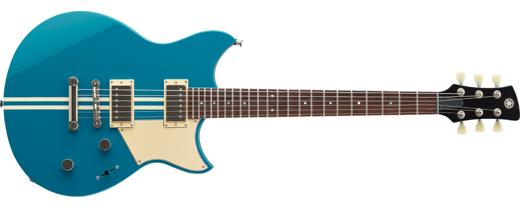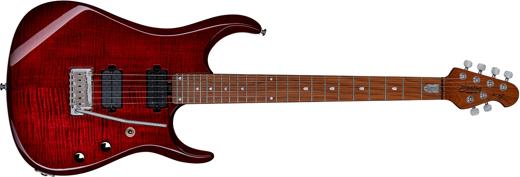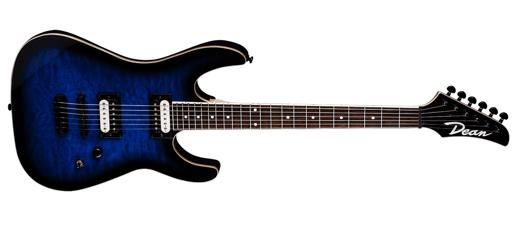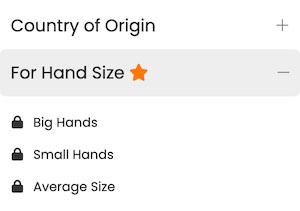Schecter Hellraiser C-7 FR Review & Prices
- From Schecter's 2006 Hellraiser series
- Made in South Korea
- 7 strings
- 26.5"'' scale
- 16" Fretboard Radius
- Mahogany body
- Mahogany 3-pc neck
- Rosewood fretboard
- Bridge pickup: EMG 707TW (Humbucker/Active)
- Neck pickup: EMG 707TW (Humbucker/Active)
- 2 volume and 1 tone Dome knobs
- 3-way Switch
- Floyd Rose 1000 Series bridge
- Thin C Set neck
- 24 XL Jumbo frets
- Grover tuners
- Compare Specs >
Our Scores and Tone Evaluation
- Heavy Metal
- Hard Rock
- Jazz
- Blues
- Funk
- Country
Schecter Hellraiser C-7 FR
- Expensive Wood
- Locking Nut
- Top Brand Pickups
- Coil Split Pickups
- Tremolo
- Retainer Bar
- Cheap Fret Wire (NS)
- No Locking Tuners
- Made in South Korea
- No Neck-Through Build
- No Weight Relief
- No Luminescent Inlay
- No Compound Radius Fretboard
- No 21:1 Tuner Ratio
- No Strap Lock
Price Overview
Its average competitor's price is $1550, which means that the Schecter Hellraiser C-7 FR is around 26% cheaper than the competition. This takes into account all instruments of the same category in our database with 7 strings and Double Locking bridge that are made in South Korea.
These are affiliate links. We may earn a fee if you purchase after clicking. These prices are prone to error. Make sure you're buying the right product after clicking on a link from our site. We are not liable if you buy the wrong product after following these links. As an Amazon Associate site we earn from qualifying purchases.
Videos





Your feedback
Not all instruments are created equally. That's why it's important to have different opinions. Here's what our users who have played this instrument say. If you've played it before, help others by voting below!
Weight
VoteTuning stability
VoteNeck speed (thickness)
VoteNeck access to high frets
VoteNeck profile shape
VoteFret edges
VotePickups noise
VotePickups power
VoteIs it Easy to Play?
The Schecter Hellraiser C-7 FR meets 3 out of our 8 criteria items for beginner friendliness, which means that it's not recommended for complete beginners. This takes into account the type of frets, scale length, nut width, bridge type, fretboard radius, and neck profile to determine the easiest combination for new players to get used to.
New Player Friendliness
Schecter Hellraiser C-7 FR- Comfortable shape
- Tall frets
- Comfortable neck
- Comfortable fretboard
- Narrow nut
- Short scale
- Locking tuners
- Easy-to-use bridge
Hand Size Comfortability
After taking into account the neck profile, scale size, fretboard radius, and nut width, we can conclude that the Schecter Hellraiser C-7 FR's construction favors people with relatively small hands.
Nevertheless, this comes down in the end to personal preference. Make sure you test this guitar—or another one with similar characteristics—before buying.
Scale Length
Scale length is the distance the strings will span between the bridge and the nut. It can tell you a lot about the overall playability and tone of the instrument. A longer scale length means longer distance between frets, brighter tone and more string tension—which means lower action, but more difficult bending of the strings.
Here's the Schecter Hellraiser C-7 FR's 26.5" scale length compared to other common sizes:
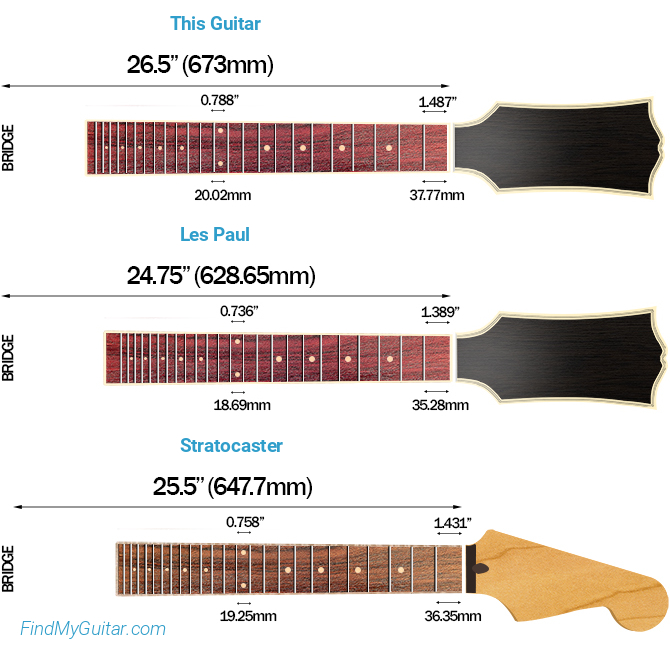
This scale is close to the popular 25.50" length, but adding an additional inch allows you to tune your strings lower while keeping the action low without causing fret buzz. This is useful for lower tunings, 7-string, or even classical guitars.
You want to avoid such a long scale if you don't plan to play in low tunings since the longer scale also means the frets are more separated, making it harder to play fast, especially for small hands.
Neck Profile

The neck profile tells you the thickness (neck depth) and shape in cross section. Every difference will completely change the feeling and comfortability of the neck. This is a highly subjective thing, but most players indeed prefer certain types of necks (like Cs and Ds) because they feel nice in most hands.
The Schecter Hellraiser C-7 FR's neck thickness is approximately 0.79'' (20.1mm) at the first fret, and 0.87'' (22.1mm) at the twelfth.
These measurements were taken either from the official Schecter website, or, in case this information wasn't provided, by researching multiple online marketplaces and forums where owners of this model have posted their measurements.
It has a C type neck. C-shaped necks like this have been the most popular for the last years. The reason is that they feel good in most hands. It's generally a thin neck that doesn't get in your way when playing fast, but that also has enough mass to give your hands a comfortable grip for chords if they aren't too big.
Thin necks like this make it easier to move your hand across the neck and it helps when playing fast solos, especially if you like to leave your thumb free while playing high on the fretboard. However, thinner necks are also weaker and will need adjustment more often than a thicker neck.
Fretboard Radius
When it comes to fingerboard radius, personal preference will dictate which one is better for you. However, most people seem to agree that a more curved (lower) radius will make it easier to play chords while a less curved (higher) radius is better for soloing and bending.
The Schecter Hellraiser C-7 FR has a 16" fingerboard radius.
Here's an image comparing this fretboard radius to other popular choices:

This fretboard radius is really different than Stratocasters, but it's also a lot flatter than Les Paul fingerboards. It'll heavily favor soloing over playing chords. This doesn't mean you can't use it for chords, but it will be more comfortable to play chords without muting strings in a more curved fretboard. Bending and sliding without losing sustain will also be more likely in a flat fretboard like this one.
Compound radius fingerboards give the best of both worlds. Unfortunately, the Schecter Hellraiser C-7 FR has the same radius across the board.
Playability compared to main competitors
Nut Width
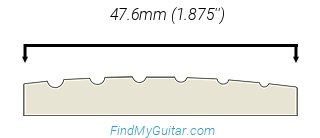
The Schecter Hellraiser C-7 FR has a nut width of 47.6mm (1.875''). This is within the most common range of nut widths for a 7-string guitar. It offers a good balance of string separation at the nut. It's the size that most guitarists prefer as it gives them just enough space to play open chords without muting the strings, but without spreading the strings too wide and making bar chords difficult to perform.
Frets
The Schecter Hellraiser C-7 FR has 24 frets. A lot of people mistakenly believe that having more frets will always be better because it gives you a higher octave. This is certainly an advantage, but there's also a disadvantage to this.
Since the fretboard will be longer, the neck pickup will need to be placed closer to the bridge. And as you may know, the further away the neck pickup is from the bridge, the warmer it sounds. This means you'll have a brighter-sounding neck pickup when using a 24-fret guitar, even if you use the same pickup on a 22-fret guitar.
It comes with nickel silver frets, so they won't last as long as stainless steel frets. If you use your instrument a lot, you might need to replace the frets after a few years. But this is unlikely as most people change instruments before this happens.
Fret Size

Finally, let's talk about fret size. Some people prefer tall frets because it's easier to press the strings and perform bends since there's less friction against the fretboard. On the other hand, some people like shorter frets because they like to touch the fretboard when playing, or because they got heavy hands and tend to press too much on the string and alter the of the note pitch accidently.
The Schecter Hellraiser C-7 FR's frets are XL Jumbo size. These are extra-large frets, which are perfect for people who truly want the least resistance for techniques like vibrato, bending, tapping, and just playing fast in general. You won't be able to feel the fretboard with these frets, so if you press too hard you'll get the notes out of pitch. It might take a while to get used to them because of this.
Playability Score
Tone Analysis
Wood will have little influence in the final tone of an electric guitar or bass. Instead, the hardware, especially the pickups, will be the most important thing to look at. Bur first, let's see the quality of the wood.
Wood
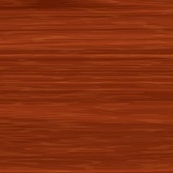
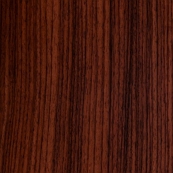
Mahogany Body and Neck: This is the type of wood found in many top-of-the-line guitars, so that's a positive point for the build quality. This red-looking wood Mahogany is found in Africa and Central America and has great sustain and a warm tone due to its high density. The downside about this type of wood is that it's relatively heavy.
Rosewood Fretboard: Since the ban of Brazillian Rosewood, this has become a rare and expensive wood. It's not usually used for guitar bodies because of this, and also because it's heavy. Instead, it's used mainly for fretboards. Sometimes it's also used for necks because it's an extremely hard wood (even harder than maple). Its tonality tends to favor warm tones.
Pickups
This guitar comes with pickups from one of the top brands: EMG. So you can expect well built pickups with great sound that shouldn't need an upgrade anytime soon.
These are active pickups, so you can expect a lot of output with a highly compressed signal that will give your tones more distortion while retaining a clear, defined sound, which is what many Heavy Metal players need. However, they have the disadvantage of sometimes lacking a fully clean sound when playing without distortion.
The Schecter Hellraiser C-7 FR's configuration is HH. With this pickup combination, you'll get warmer tones and more output than using single coils. Humbucker pickups cancel the noise that single-coil suffer from, which also results in a warmer tone. This pickup combination isn't only for high-gain music like Hard Rock or Heavy Metal. Their warmness is also popular for Jazz, Indie, R&B, Blues and more.
More with the same pickups
Versatility
It comes with the popular 3-way switch that is present in most guitars. For more versatility, players tend to prefer a 5-way switch, although it all depends on what you want to use your guitar for.
It has a Coil Split option. It allows you to 'split' or turn off pickup coils to get even more tones in combination with the pickup selector. When used with humbucker pickups, it'll reduce the output and increase their clarity, turning them essentially into single-coil pickups.
Diagram

What music genre is it good for?
As a 7 strings, Solid Body guitar with HH configuration and Active pickups, we'd recommend it for genres like Heavy Metal or similar. However, you can use almost any guitar for any genre. This is just the typical type of music for this particular one.
Sound Score
Build Quality Analysis
Country of Origin
Knowing where the instrument is produced is a good way to know how well it's built. Some manufacturing countries are known for having higher quality standards. For example, most expensive instruments are made in the US or Japan, but there are some exceptionally great countries—like South Korea—that are building a good reputation.
The Schecter Hellraiser C-7 FR is made in South Korea. Guitars made here are well-built and tend to have good quality control, even though they focus on mass production. This used to be the most premium option just below Japan or the US, but other countries like Indonesia are becoming great competitors because of even cheaper labor without sacrificing quality.
Bridge
Floyd Rose 1000 Series: With this type of tremolo bridge, you'll be able to perform dive bombs and pinch harmonics without getting out of tune. This type of bridge gives you the best versatility, but it also makes it harder to set up your guitar correctly, especially when changing your strings.
Nut Material
Another important thing to analyze is the nut material, as it's one of the most important aspects that can affect the sound and playability of your guitar. A well-cut nut will make sure it stays in tune and will make it more comfortable to play.
In this case, the Schecter Hellraiser C-7 FR has a Locking nut. Instead of the typical nut, this nut locks the strings in place and will make them stay in tune even after heavy tremolo use. This type of nut provides the best tune stability, but they also make the guitar more expensive.
It also comes with a retainer bar for the locking nut, which is a helpful addition. Without it, the strings would change pitch once you lock down the nut, so you'd have to make more micro-adjustments at the bridge to tune it correctly.
Neck Joint
The neck joint is the part where the neck of the guitar meets the body. There are three main techniques to attach both parts together: Set-In, Bolt-On and Neck-Through. The latter two provide different advantages, although neck-throughs are the most expensive.
This guitar has a Set neck joint. This type of neck joint consists of using different pieces of wood for the neck and the body of the guitar. Both pieces are then glued together. This is more expensive to make than a bolt-on neck, but it's cheaper than a neck-through guitar. Some people believe that this gives more sustain than a bolt-on neck due to both pieces having a 'better connection' than with bolts. Still, it's something difficult to prove.
However, this type of neck joint does have the disadvantage of not allowing you to easily swap the neck for another. This makes this type of neck joint less mod-friendly.
Build Quality Score
All Specs
Schecter Hellraiser C-7 FRMore Popular Comparisons With This Guitar
User Reviews
Help others by sharing your opinion about this guitar. Note: to avoid spam, your review will be submitted for approval before appearing here.
